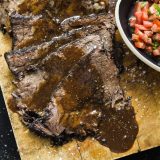In the Spanish-tiled kitchen at Caffé Lunático, in Cartagena’s hip Getsemani neighborhood, Carmen Herrera assembles her seasonings—a cinnamon stick, allspice berries, whole cloves, orange peel.
The ingredients suggest mulled wine, but she’s preparing sirloin tip.
Gobs of minced garlic, a glug of cabernet and generous pinches of salt and black pepper go into the pan with the meat and whole spices. Finally, she takes a block of rock-hard panela sugar and grates it over the beef as one would a hunk of Parmesan.
The meat will marinate for 24 hours before it is seared, then leisurely braised. The braising liquid will be reduced to a rich sauce. The result is sable-colored beef and a glossy, deep brown sauce.
When I dig into the dish—served with caramelized plantains and yucca fritters on the side—the tender meat shreds with the swipe of a fork. But the sauce is the true star: Dark, spiced, sweet but balanced, it's reminiscent of Kansas City-style barbecue sauce but thinner, more complex and without any of its ketchupy undertones. I would happily order this by the cup.
This dish is not a reflection of Caffé Lunático's contemporary approach to cooking. It's posta negra, a classic recipe from Cartagena—a beacon of Colombian cuisine on the Caribbean Sea.
Named for the deep hue the beef takes on as it braises, posta negra is a more temperate example of Cartagena’s sweet tooth, evidence of which is found across the city. In the Portal de los Dulces, an arched loggia occupied by candy vendors that’s been memorialized by Gabriel García Márquez. In the cheap streetside cocktails served in freshly hewn coconuts. And in the heady flavor of Kola Roman, an ultra-fizzy, neon-red vanilla soda that is as free-flowing and celebrated in Cartagena as maple syrup in Vermont.
In fact, that cola sometimes turns up in posta negra marinades, always accompanied by the warming spices and panela (a robust, unrefined brown sugar—see below). More traditionally, the liquid is red wine. That’s what Herrera used, and it’s what Proyecto Caribe chefs Jaime Rodríguez and Sebastian Pinzón use in their posta negra, as well.
Rodríguez and Pinzón, who regularly host pop-up dinners in Cartagena, also incorporate tamarind into the meat’s marinade, giving the sauce tangy, fruity flavor. We loved this approach to pot roast, one in which the sauce is as important as the meat it braises. So we took inspiration from Rodríguez and Pinzón's unconventional riff when crafting our own recipe for this fresh, distinctively Cartagenan dish.
Since tamarind pulp can be challenging to find, we turned to a more common ingredient that also offers flavorful advantages: prunes.
Prunes had the right amount of caramel-like sweetness to pair well with posta negra’s sauce, but they’re also rich in soluble fiber. As they cook down, that fiber dissolves into the liquid, giving viscosity to the sauce. And because prunes undergo the Maillard reaction as they’re dried, they also provided the proper deep-brown pigment.
For our recipe, we skipped the long marination and instead braised boneless chuck roast in a combination of the traditional spices, dry red wine, a cup of prunes, as well as Worcestershire sauce and tomato paste. A few hours later, we had a tender roast with a dark exterior and a smooth, rich sauce with all the hallmark flavors of classic posta negra.
Raw sugars—rare in the U.S. but common in cooking around the world—are unfiltered and unrefined, qualities that leave intact their naturally earthy, fruity flavors and more robust textures.
Though similar in color, moisture and richness to conventional dark brown sugar—which is not raw, but refined white sugar blended with molasses—the flavors of raw sugars tend to be deeper and more pronounced.
But could they be used in place of brown sugar? To find out, we tested a variety of raw sugars in a classic blondie recipe, substituting them equally for the brown sugar. To let their flavors shine, we omitted the vanilla, nuts and chocolate chips.
Muscovado, made from sugarcane in Mauritius and the Phillipines, has an earthy, bittersweet flavor that gave the blondies a flavor similar to a molasses cookie. Though a bit moister than brown sugar, our blondies baked up fine.
Piloncillo, common in Mexican and Latin American cooking, and panela, from Colombia, are made from boiled down sugarcane and sold in hard disks or cones. They have a caramel, almost fermented taste and need to be grated before using (the large holes on a box grater worked well). Both were delicious in the blondies, adding richness without being overwhelming.
Jaggery and palm sugar are used in Southeast Asia. The former is made from a blend of sugarcane and date palm sap while the latter uses only date palm. Both have an almost maple-like flavor, but neither worked well in our blondies. Coconut Sugar, made from cooked down coconut palm sap, had a milder flavor, was a bit less sweet and gave the blondies a cakier—but not unpleasant—texture.
The biggest surprise? The blondies made with regular brown sugar tasted lackluster compared to every batch made with raw sugar.




